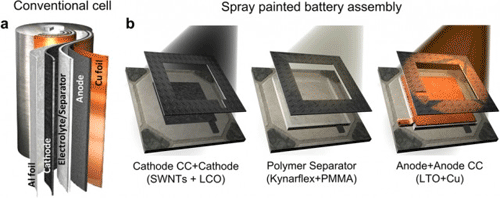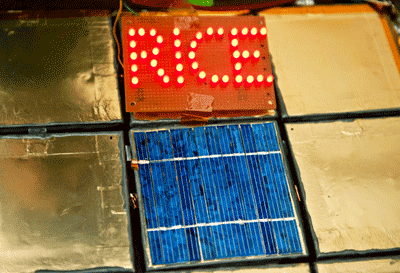Paint-based lithium-ion batteries gives power sources improved form factor
BY BEN STRACK
Scientists at Rice University have developed a technology that transforms household items into lithium-ion batteries.

Material scientists at Rice University develop the first paint-based lithium-ion battery.
Batteries have always limited technology: whether it’s how long the gadget lasts or the thickness of the device itself, they tend to be more of a hurdle than they are helpful. Even with batteries getting smaller over the years, thereby increasing the portability of technology, the scientists at Rice have one-upped even the slimmest of designs.
The first paint-based, spray-on batteries are as innovative as they are useful in making items such as a beer mug, bathroom tiles, and stainless steel into an efficient energy source.
How does the spray-on battery work?
As we all know, every standard battery includes layers that consist of charge collectors, the cathode / anode, and the electrolyte in the center. In order for these batteries to fit inside often small devices like a flat iPhone or an extra-slender Galaxy Nexus tablet, the battery layers are rolled up, or stacked vertically.
So, it turns out ogres, onions, and batteries all have layers.
But what if those layers were paint-based and could be applied to almost any surface by simply spraying it on? This would no doubt open the realm of possibility for simple technology to become something much more fascinating. Well, the scientists at Rice were able to do just that by placing foils of aluminum, copper, graphite, and lithium compounds within layers of paint that, in turn, would stick to glass, plastic, ceramic, and metal surfaces.
The paint-based battery’s layers breakdown as follows: the first layer consists of single-walled carbon nanotubes; the middle layers are made up of the cathode, polymer separator and anode; and the final layer is the negative charge collector made from a commercially accessible copper conductive paint.

Despite being constructed a little differently, the conventional and spray-painted batteries have similar components.
Before application, the battery area is vacuum dried, soaked in an electrolyte (which the polymer separator absorbs completely), and then sealed with a polymer laminate. After completion, the lithium-ion battery is only 200 microns thick, equivalent to the width of two human hairs.
Video
Watch the researchers make paint-based lithium-ion batteries:
Demonstration yields satisfying results
The team at Rice showcased its discovery by spraying the battery on nine ceramic tiles. The battery, charged by a solar cell, was able to sustain constant output of 2.4 volts. In the demonstration, it was able to illuminate 40 LEDs (spelling out “RICE”) for six hours.

The battery proved effective in a demonstration, lighting up 40 LED bulbs for six hours.
Impressively, a white laboratory light was all the solar panel needed to provide this steady supply of power. With paintable solar cells recently reported, the scientists believe they can be fused with the paintable batteries to create an impressive combination.
Outlook
Although Rice University’s battery supplies a rather small amount of power in comparison to batteries found in modern-day computers and phones, finding a way to upscale this project does not seem out of the question.
The researchers have already filed for a patent on the technique, which they will continue to enhance. Hopes for the future include seeking electrolytes that would make it easier to construct painted batteries in the open air, as well as designing snap-together tiles able to be arranged in a number of ways.
If such visions become a reality, with only a few coats of paint and some light needed to power technology, batteries (and similar devices like sensors, computer chips, etc.) could be printed on anything from clothing to walls, your body as a tattoo, perhaps even in the air we breathe.
Moving away from conventional battery storage units is an exciting step forward on any path we may choose to explore in the coming years.
Download their paper here: Paintable Battery ■
Story via: Rice University
Advertisement
Learn more about Electronic Products Magazine





